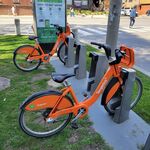nfitz
Superstar
Presto will be implemented by mid-2017 - heck by January 2017 if they meet their current schedule.It's going to be a done deal by mid-2017 - not that long a time when the planning horizon is 10, 15, 30 years from now.
But to implement POP system wide (buses and subways), they'd have to do a lot more, that there are no plans for. And to do fare by distance, they need to replace a lot of stations gates and exits, which is also not planned; there's some baby steps towards that, but nothing on the order that would be needed for full implementation.




